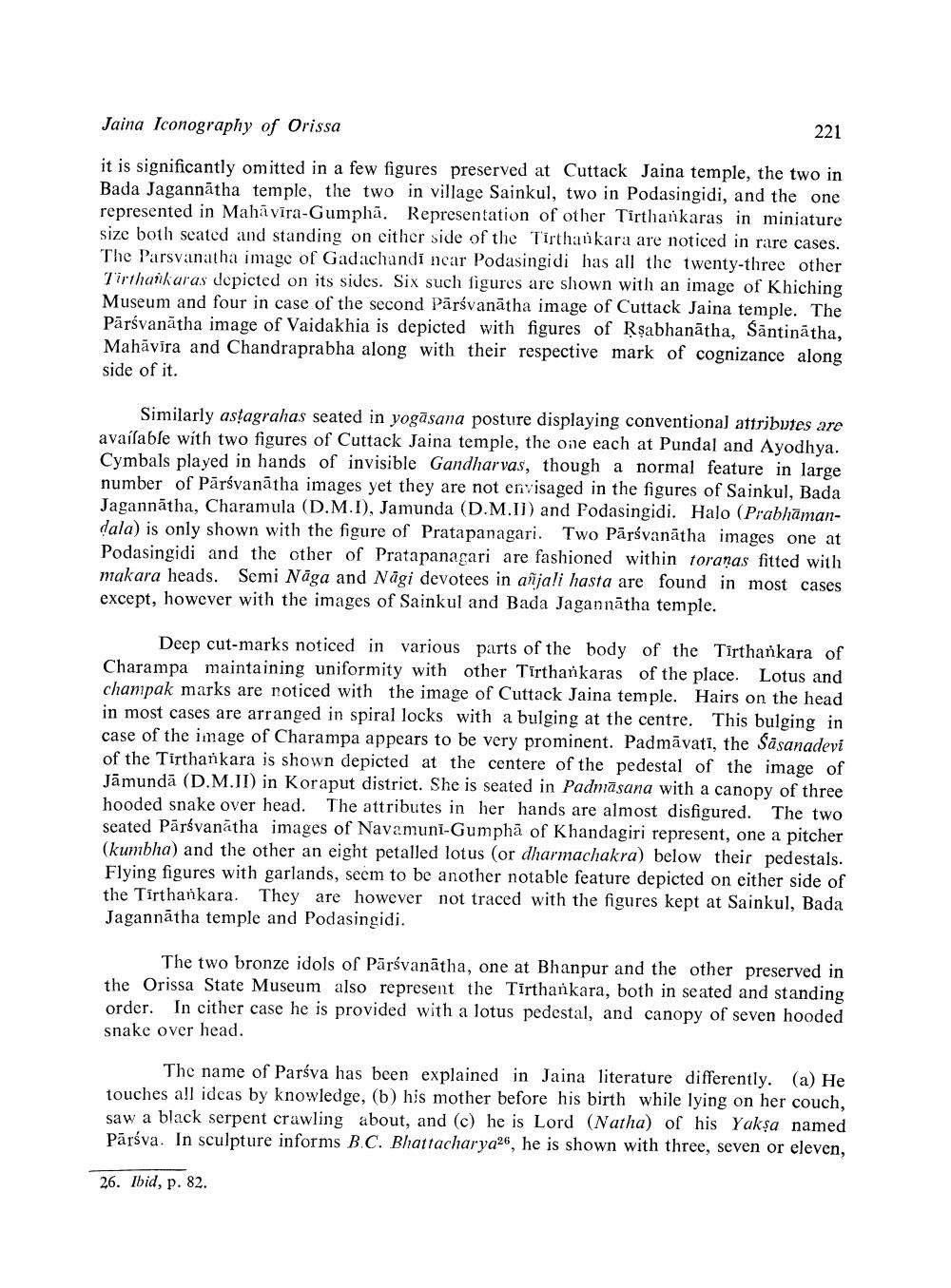________________
Jaina Iconography of Orissa
221
it is significantly omitted in a few figures preserved at Cuttack Jaina temple, the two in Bada Jagannātha temple, the two in village Sainkul, two in Podasingidi, and the one represented in Mahāvīra-Gumphā. Representation of other Tirthankaras in miniature size both seated and standing on either side of the Tirthankara are noticed in rare cases. The Parsvanatha image of Gadachandi ncar Podasingidi has all the twenty-three other Tirthankaras depicted on its sides. Six such figures are shown with an image of Khiching Museum and four in case of the second Pārsvanātha image of Cuttack Jaina temple. The Pārsvanātha image of Vaidakhia is depicted with figures of Rşabhanātha, Sāntinātha, Mahāvīra and Chandraprabha along with their respective mark of cognizance along side of it.
Similarly astagrahas seated in yogāsana posture displaying conventional attributes are available with two figures of Cuttack Jaina temple, the one each at Pundal and Ayodhya. Cymbals played in hands of invisible Gandharvas, though a normal feature in large number of Pārsvanātha images yet they are not envisaged in the figures of Sainkul, Bada Jagannātha, Charamula (D.M.I), Jamunda (D.M.I]) and Fodasingidi. Halo (Prabhämandala) is only shown with the figure of Pratapanagari. Two Pārsvanātha images one at Podasingidi and the other of Pratapanagari are fashioned within toranas fitted with makara heads. Semi Nāga and Nāgi devotees in añjali hasta are found in most cases except, however with the images of Sainkul and Bada Jagannātha temple.
Deep cut-marks noticed in various parts of the body of the Tirthankara of Charampa maintaining uniformity with other Tirthankaras of the place. Lotus and champak marks are noticed with the image of Cuttack Jaina temple. Hairs on the head in most cases are arranged in spiral locks with a bulging at the centre. This bulging in case of the image of Charampa appears to be very prominent. Padmāvati, the Sāsanadevi of the Tirthankara is shown depicted at the centere of the pedestal of the image of Jāmundā (D.M.II) in Koraput district. She is seated in Padmāsana with a canopy of three hooded snake over head. The attributes in her hands are almost disfigured. The two seated Pārsvanātha images of Navamuni-Gumphā of Khandagiri represent, one a pitcher (kumbha) and the other an eight petalled lotus (or dharmachakra) below their pedestals. Flying figures with garlands, seem to be another notable feature depicted on either side of the Tirthankara. They are however not traced with the figures kept at Sainkul, Bada Jagannātha temple and Podasingidi.
The two bronze idols of Pārsvanātha, one at Bhanpur and the other preserved in the Orissa State Museum also represent the Tirthankara, both in seated and standing order. In cither case he is provided with a lotus pedestal, and canopy of seven hooded snake over head.
The name of Parśva has been explained in Jaina literature differently. (a) He touches all ideas by knowledge, (b) his mother before his birth while lying on her couch, saw a black serpent crawling about, and (c) he is Lord (Natha) of his Yaksa named Pārsva. In sculpture informs B.C. Bhattacharya26, he is shown with three, seven or eleven,
26. Ibid, p. 82.




